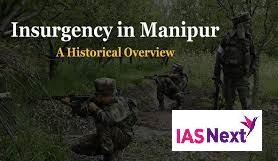CURRENT AFFAIRS
Get the most updated and recent current affair content on Padhaikaro.com
Manipur Insurgency
- IAS NEXT, Lucknow
- 24, Feb 2022

Reference News:-
Defence Minister Rajnath Singh, while addressing an election rally on February 14 in Imphal West, called upon insurgency groups operating in Manipur to shun violence and come to the negotiating table.
- He said that the menace of insurgency had been waning and the Centre is ready to hold dialogue with them to bring lasting peace to the region.
Rise of insurgency in Manipur
- Insurgence rooted in Independence: The emergence of insurgency in Manipur dates back to 1964 with the formation of the United National Liberation Front (UNLF), which still remains one of the formidable militant outfits.
- Allegation of Forced Merger: The rise of separatist insurgency in Manipur mainly attributed to perceived discontent over alleged “forced” merger of Manipur with the Union of India and the subsequent delay in granting it full-fledged statehood.
- While the erstwhile Kingdom of Manipur was merged with India on October 15, 1949, it became a state only in 1972.
- Rise of Valley based outfits: The later years saw a slew of militant outfits being formed, including the People’s Liberation Army (PLA), People’s Revolutionary Party of Kangleipak (PREPAK), Kangleipak Communist Party (KCP), and Kanglei Yawol Kanna Lup (KYKL), among others. These valley-based outfits have been demanding an independent Manipur.
- Threat to Manipur Territorial due to Nagalim demand: The Naga movement in neighbouring Nagaland spilled over into Manipur’s hill districts with the NSCN-IM controlling most of it while pressing for “Nagalim” (Greater Nagaland), which is perceived in the valley as a “threat” to Manipur’s “territorial integrity”.
- Nagas Vs Kukis: While the hills account for nine-tenths of Manipur’s geographical area, they are sparsely populated, with most of the state’s population concentrated in the valley. The Meitei community forms a majority in Imphal valley, while the surrounding hill districts are inhabited by Nagas and Kukis.
- In the early 1990s, the ethnic clashes between Nagas and Kukis led to the formation of several Kuki insurgent groups, which have now scaled down their demand from a separate Kuki state to a Territorial Council.
- Imposition of AFSPA: In 1980, the Centre declared the entire Manipur as a “disturbed area” and imposed the controversial Armed Forces Special Powers Act (AFSPA) to suppress the insurgency movement, which remains in force till date.
Ceasefire agreement
- The NSCN-IM entered a ceasefire agreement with the Government of India (GoI) in 1997, even as peace talks between them have still been continuing.
- Similarly, the Kuki outfits under two umbrella groups, the Kuki National Organisation (KNO) and United People’s Front (UPF), also signed the tripartite Suspension of Operation (SoO) pacts with the GoI and Manipur on August 22, 2008.
- Of the total 25 armed Kuki groups operating in the state, 17 are under the KNO and 8 under the United Peoples’ Front (UPF).
- However, major valley-based militant outfits (Meitei groups) such as the UNLF, PLA, KYKL etc. are yet to come to the negotiating table.
- Many of their smaller outfits have however entered the SoO agreement with the state government, which has launched rehabilitation programmes for such groups.